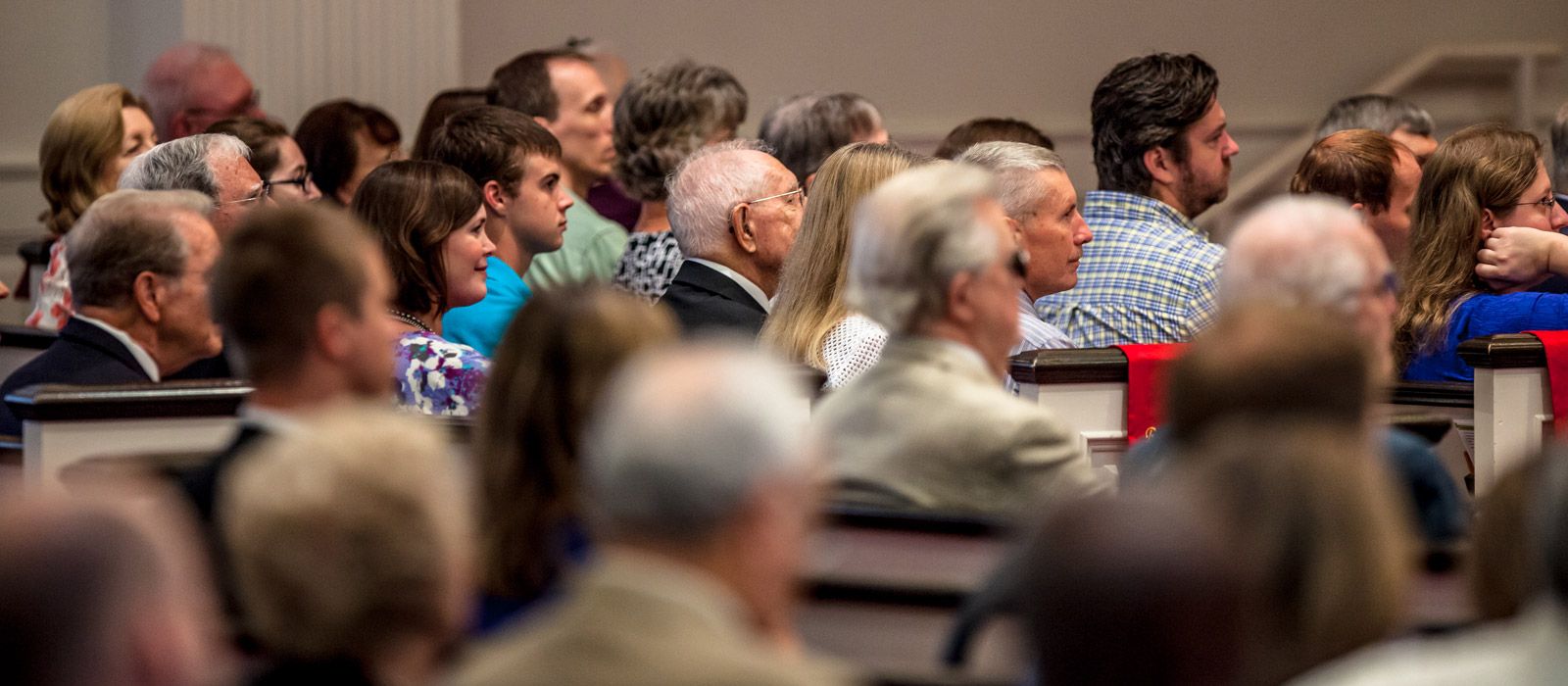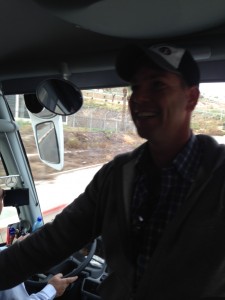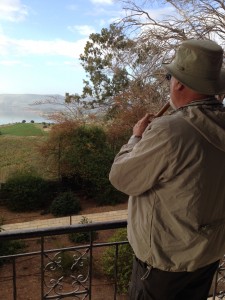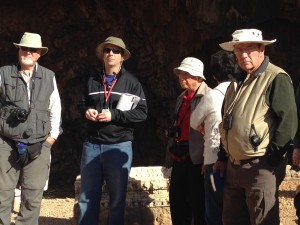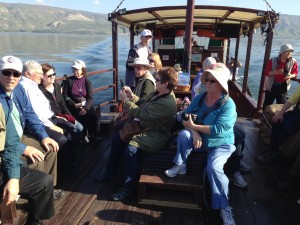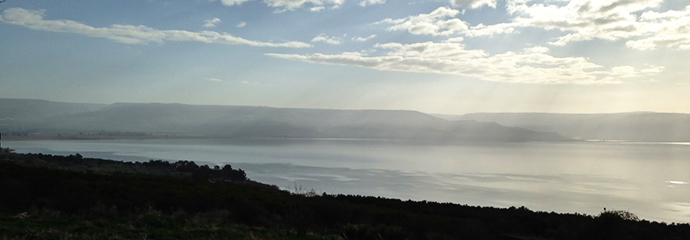
Israel Trip – 4
The Sea of Galilee is the stage for so many performances in Jesus’ ministry. He was full of surprises for the disciples and the crowds. Today, we boarded the boat and journeyed together through so many exciting places on and around the Sea. We even had a few surprises of our own along the way.
To start our day, we surprised our guide and bus driver with souvenir hats and shirts from Florida State’s national championship. They were truly thrilled. Our guide was in West Palm Beach for the game. When he saw a couple of the guys wearing FSU caps, he mentioned how much he would like to have one. Little did he know that the group had already planned something special before we left. He wore the hat proudly and gave us a few Seminole “Chops.”
Our first stop was just a few miles from our hotel at the Church of the Beatitudes, the traditional site of Jesus’ Sermon on the Mount. I quoted a section of the sermon and sang, “I Walked today Where Jesus Walked.” Dr. Dale Olsen played his Cypriot flute.
From there, we traveled north to the Israeli-Syrian border to visit the Banias, the site of Caesarea-Philippi. Our guide and I taught together. This region, once ruled by Herod Philip, the son of Herod the Great, was the site of Peter’s confession that Jesus “is the Christ, the Son of the Living God.” During Jesus’ day, Romans traveled to C-P to worship the god Pan/Faun. Most people today recognize Pan from C.S. Lewis’s book, The Lion, the Witch, and the Wardrobe. Mr. Tumnus, the faun, was half man and half goat, similar to Pan.
In the first century, Pan was more than a character in a story. He was a god that evoked fear in his followers; the root of our word panic comes from Pan. The ancients believed that nymphs appeared and played near the springs. The locals trained goats to dance and staged a show to honor the god. Tall rock cliffs, flowing streams, and springs mark this site. The headwaters of the Sea of Galilee and eventually the Jordan River are here.
Jesus leads his disciples to this sacred place to show them the true purpose of his mission. He shows them that he is the true source of water and life. He says, “On this rock, I will build my church; and the gates of Hades will not prevail against it.” Here you can imagine his gesture to rocks at C-P. He is the firm foundation as he calls out the church and brings in the kingdom of heaven.
This place is the turning point of his ministry. He says, “If anyone wants to come after me, let him deny himself, take up his cross and follow me.” Much to Peter’s dismay, he shows them what kind of Christ is he is going to be– one who suffers and dies, not a king who overthrows the government with military, money, and politics. He overcomes the world with the power of love.
On the way to lunch, we had our next surprise. We stopped at a kibbutz that manufactures Tiva Shoes. We then ate a lunch of local tilapia, also known as “St. Peter’s Fish.” Here you can order it the way it’s meant to be eaten–with the head still attached.
We boarded a small fishing boat and embarked on a journey across the Sea of Galilee. I taught about the significance of Jesus’ miracles, and we paused to reflect on Jesus (and Peter’s) famous walk on the water in Matthew 14.
When we reached the shore, we visited a kibbutz that is home to “The Galilee boat,” a first century boat discovered and excavated from the shores of the Galilee in 1986. It is preserved and maintained here and holds approximately 13 people.
Our next stop was Tabgha, the traditional site of the feeding of the 5,000. We then drove to Capernaum, home of a fourth century A.D. synagogue, excavated homes, and the traditional site of Peter’s mother-in-law’s house. I taught on the significance of Jesus’ teaching at the beginning of his public ministry in Mark 1. Coincidentally we arrived at sundown, during the same time of day when Jesus healed many people of various diseases in Capernaum. We could see how Jesus’ message spread so quickly. Evidence suggests that the earliest church in Capernaum met in a house in this place.
Our last stop of the day was the best surprise of all. For the last few years, archeologists have been excavating Magdala. Located along the shores of Galilee, this village is the home of Mary Magdalene, from whom Jesus cast out seven demons. We arrived at dusk, when most normal sites would be closed. This site has not officially opened as a tourist destination, so the archeological team was eager to great us. The Catholic Church owns the site and is excavating it for the Israeli government. We were guided by a young woman named Claudia who is from El Salvador. She showed us the remains of a synagogue discovered in 2007 that dates to A.D. 29. The small room is no larger than an average size American master bedroom. Around the sides are blocks where leaders of each household sat on the ground level. In the middle is a replica of a block they discovered where the rabbi sat to interpret the law. The original is in the Israeli museum in Jerusalem.
Claudia showed us bath houses (mikvehs) near the synagogue where the water flows from underground springs. They have also found mosaic floors intact.
The “Duc in Altum” (“Put Out into the Deep”) spiritual center is under construction close to the water. The building is dedicated in memory of 8 women who followed Jesus. The center of the altar and pulpit area is a large boat reminiscent of Jesus’ day. Four chapels depict miracles Jesus performed around Galilee- the exorcism of Mary Magdalene, the raising of Jarirus’s daughter, and Jesus’ and Peter’s walk on the water. The place is truly amazing.
As our day draws to a close, I’m reminded of why the boat became such an important vehicle for transporting disciples. Jesus taught from a boat and transported his crew. In Matthew and Mark especially, Jesus’ boat was a metaphor of life as the church. Just as Jesus called out a group to be built on the rock, so they also journeyed together through storms and successes, friendships and betrayals. It was truly a fellow-ship. They learned to follow Jesus, to get in the boat with him, and to trust him and each other through the journey. When life was dark and stormy, they turned to the one walking out to them on the water. They trusted in the man who could fall asleep in the midst of storms and calm the angry waves. Jesus used the boat to prepare the disciples for his departure one day. They learned to work together as they followed him. Are you in the boat with Jesus? Do you trust the other passengers who are with you? That’s what church life together is all about. If so, you can trust him as your Captain; he will guide you safely home.

